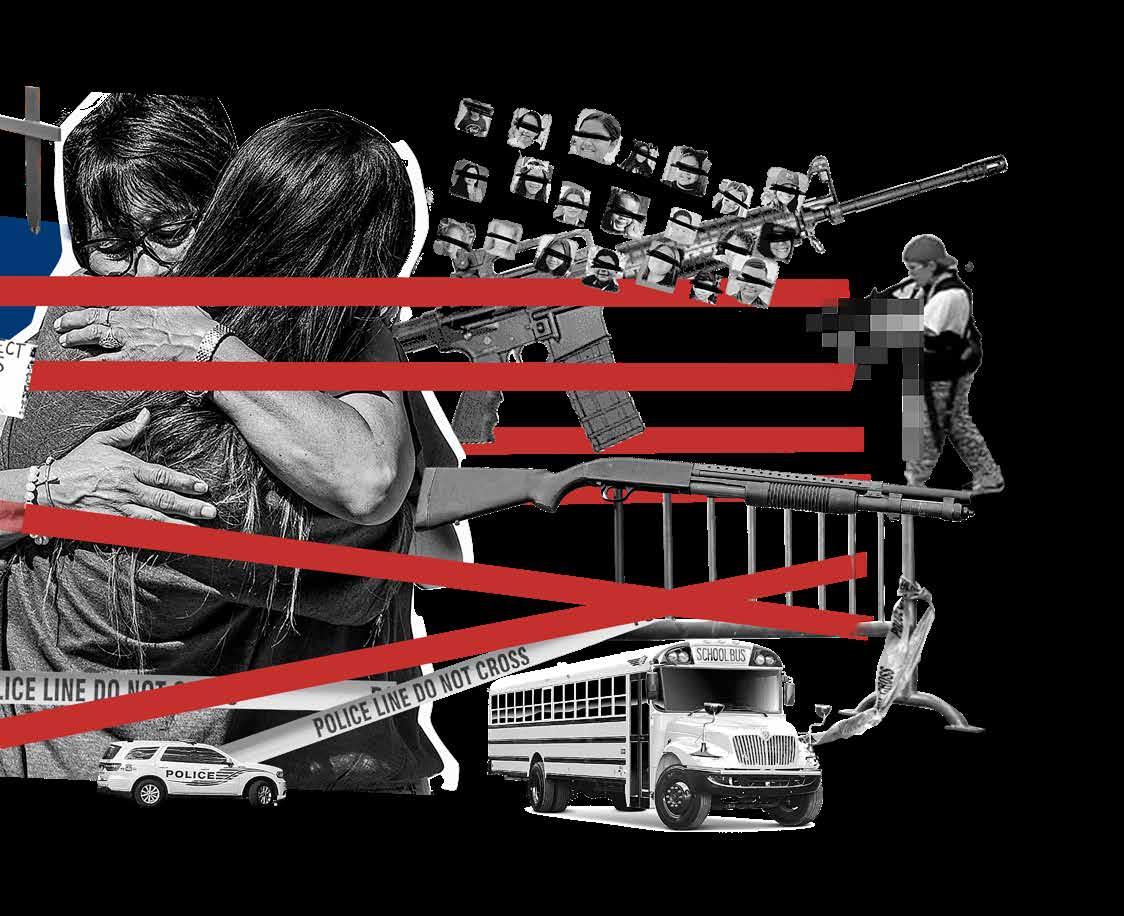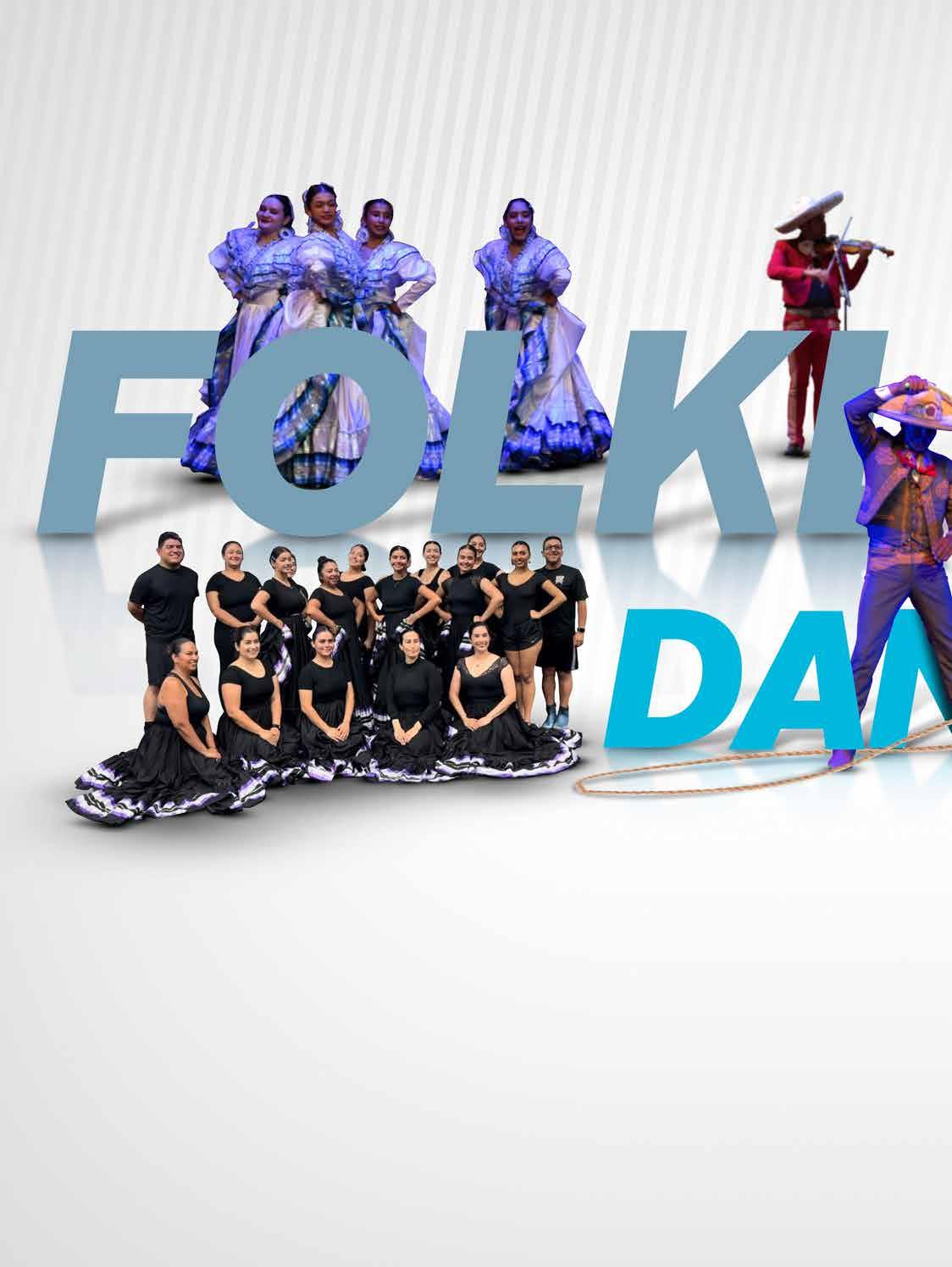

USA and Mexico Looking for justice
“While today’s sentence cannot possibly lives lost or undo the harm done to the those otherwise impacted by this horrific our hope this sentence of 90 consecutive brings some finality and peace to those

FIRST ASSISTANT
U.S. ATTORNEY
MARGARET LEACHMAN FOR THE
possibly replace the the survivors and horrific event, it is consecutive life terms those effected.”




Areli Rojas Rivera, Arcelia Guerrero Tapia, Lorena Cano Bastar
@BARBIEROJA / @ARCELIAGUERRER1 @LOCANO_
The challenge of stopping firearms trafficking to achieve peace

TStates to Mexi co has become one of the most critical national security issues on the bilateral agenda. According to the Ministry of Foreign Affairs, approximately 70% of homicides in Mexico are committed with firearms.
IN CAMINO VERDE, A 13-YEAR-OLD TEENAGER WAS WALKING AS HE USUALLY DID ON THE STREETS OF TIJUANA WHEN SUDDENLY AN INDIVIDUAL ATTACKED HIM WITH A FIREARM, TAKING HIS LIFE. FIFTEEN SHELL CASINGS WERE FOUND AT THE SCENE, AND IT WAS DETERMINED THAT THE ATTACK WAS DIRECT. SADLY, JOSÉ “N” WAS ONE OF THE MANY YOUNG VICTIMS OF ORGANIZED CRIME GROUPS INVOLVED IN ILLICIT ACTIVITIES SUCH AS ARMS TRAFFICKING.
In addition, the Ministry of National Defense of Mexico (SEDENA) reports that between 70% and 90% of these weapons are trafficked from the United States. This criminal activity is a significant concern for the citizens and has been a focus for security authorities in both nations.
It is unclear how many illegal firearms exist in Mexico. Still, studies by institutions such as the Center for Social Studies and Public Opinion of the Chamber of Deputies estimate that there could be more than 15 million. According to the U.S. Bureau of Alcohol, Tobacco, Firearms, and Explosives (ATF), most of these weapons are purchased from businesses in California, Arizona, New Mexico, and Texas.
which is also one of the largest worldwide. As of 2023, the United States detained 100 people for illegal firearms trafficking since the enactment of the Bipartisan Safer Communities Act. Between October 1, 2022, and June 30, 2023, nearly 2,000 firearms and more than 80,000 rounds of ammunition were seized in Operation Southbound.
Additionally, Operation Without a Trace, from its inception until June 2023, has resulted in over 700 arrests, the seizure of more than 1,900 firearms, and the seizure of over 850,000 rounds of ammunition. The U.S. government also opened an additional ATF and Department of Justice office in Guadalajara.
Mexico, for its part, has the National Security Law and the Federal Law on Firearms and Explosives to prohibit the trafficking and use of illegal weapons. Through SEDENA, from December 1, 2018, to January 31, 2024, 47,996 firearms were seized, most of them for exclusive military use. Additionally, from January 1, 2023, to June

Moreover, the Mexican govern ment has implemented a series of social actions to address the causes of insecurity and violence in the country. One such action is the Voluntary Disarmament program launched by the Ministry of Security and Citizen Protection (SSPC) in 2021. The goal of this program is to remove firearms from homes and community spaces to prevent violence. It offers citizens a peaceful option to voluntarily dispose of their weapons in exchange for a financial incentive.
Every weapon handed in represents an opportunity to reduce crimes, homicides, femicides, accidents, and other forms of violence. The arms exchange process is simple and without legal consequences. Each surrendered weapon is destroyed on the spot by specialized SEDENA personnel to ensure its removal from the streets.
The illegal trafficking of firearms from the U.S. to Mexico is a critical security issue on the bilateral agenda.
of Mexico’s federal entities. A total of 951 short firearms, 594 long firearms, 83,563 rounds of ammunition, 3,178 magazines, 1,908 detonator or percussion caps, 246 grenades, 194 detonators, 15 dynamite cartridges, and one mortar shell were exchanged and destroyed.
The program has been successful, with clear benefits for communities and individuals. Most participants in the Voluntary Disarmament sessions were men (62%) and women (38%). Of these, 93% found the arms exchange helpful in reducing violence in their community, and 100% would recommend the program to family, friends, or neighbors.
mited to intentional homicides but also applies to the reduction of the robbery violence rate per 100,000 inhabitants in the municipality, which decreased from 331.10 to 260.48 during the same period. This success has been replicated in various states and cities where the voluntary disarmament campaign has been deployed. Community participation, sensitization, and education activities yield optimal results in lowering violence levels and improving public safety.
Every weapon handed in represents an opportunity to reduce crimes, homicides, femicides, and other forms of violence.
her ex-husband for domestic violence. She explained that he had threatened her with the weapon. Upon learning the firearm would be destroyed, she requested to be present. While the authorities carried out the destruction, the woman broke down in tears. Only she knows what that weapon symbolized.”
From December 4, 2021, to August 2, 2024, 63 municipalities
To illustrate the positive impact of the voluntary disarmament campaigns, we can analyze the rate of intentional homicides in Nezahualcóyotl, a crime directly linked to the use of firearms. Between 2022 and 2024, the rate per 100,000 inhabitants showed
“In August 2022, while the Voluntary Disarmament action was taking place in Ciudad Nezahualcóyotl, State of Mexico, a roughly 60-year-old woman approached. Like many other participants, she appeared nervous due to the fear or uncertainty that carrying a firearm generates, as well as the basic fear of being detained. However, the woman showed a revolver she intended to surrender. During the paperwork, she was
Stories of illegal firearm possession like this one are familiar across the country, from grandmothers surrendering weapons to prevent their grandchildren from engaging in criminal activities to individuals no longer wanting the risk associated with having a gun in their homes. Undoubtedly, combating arms trafficking and the illegal use of firearms is not easy and has a long way to go. However, through coordination between governments, raising civil awareness, and decisive actions based on intelligence and addressing the root causes of violence, we can achieve peace.

THERE IS A LACK OF RESOURCES TO SUPPORT CRIME VICTIMS
WHO WILL PROTECT MEXICO’S INDIGENOUS CRIME VICTIMS?
As Mexico’s newly elected authorities strategize on ways to reduce years of elevated crime and violence, special attention is needed on a decade-old provision intended to protect the rights of victims.
BY LAURA CALDERÓN, JANICE DEATON, AND DAVID SHIRK
As Mexico’s newly elected authorities strategize on ways to reduce years of elevated crime and violence, there is help in an overlooked and underutilized law aimed at victims’ rights. According to Mexico’s General Crime Victim Law (Ley General de Víctimas) passed in 2013, crime victims must be represented by competent “victim counselors” (asesores jurídios) who work to protect the rights and interests of the victims throughout the legal process, beginning with the investigation and continuing through the sentencing and reparations hearings.
However, implementation of this law has been lacking and, after more than a decade, many crime victims still lack access to justice due to a scarcity of qualified victim counselors. There has been insufficient training and attention on this specialized area of law, coupled with a lack of resources to support crime victims. Because criminal cases cannot proceed without a legal victim representative, the lack of counselors contributes to significant case backlogs throughout the country.
This problem has been especially concerning to legal advocates in the Pacific Coastal state of Oaxaca, one of the most dangerous states in Mexico for women. Oaxaca is also one of the poorest states in Mexico, with about 30% of inhabitants living in moderate poverty and 10% living in extreme moderate poverty, according to Mexico’s Secretary of the Economy. Additionally, the state’s indigenous communities suffer from a severe lack of access to legal assistance due to resource limitations and a variety of linguistic and cultural barriers.
LAURA CALDERÓN EXECUTIVE DIRECTOR FOR JUSTICE IN MEXICO
While Mexico grapples with escalating crime rates and systemic challenges in victim protection, ALIVIO employs an underused law to help crime victims access justice.

PHOTOART: ALEJANDRO OYERVIDES
ALIVIO!

According to the Atlantic Council, more than 70% of Mexican women and girls currently over the age of fifteen have experienced some form of violence. Unfortunately, since 2020 the Mexican government has cut funding for women’s shelters throughout the country as a cost-savings measure, reducing a crucial form of support for female victims of violence.
Oaxaca’s rich linguistic diversity also presents a significant legal obstacle for providing legal assistance to indigenous women. Zapotec is the most widely spoken indigenous language (with more than 350,000 speakers), followed by Mixteco (nearly 250,000+), Mazateco (200,000+), Mixes (100,000+), and Chinantecos (100,000+).
According to Mexico’s national crime victim survey (ENVIPE), over 90% of homicide cases in Oaxaca do not reach sentencing, and the rate of impunity for femicide cases is closer to 98%. For example, in 2022, Oaxacan singer Jazmín Zárate, whose songs protested gender violence, was found murdered in an abandoned lot in San Lorenzo Cacaotepec, on the outskirts of Oaxaca City. She had been stabbed numerous times in the neck and chest. Her death remains unsolved.
In 2019, Oaxacan attorneys who specialize in victim counseling, Alicia Valentín and Aketzali Flores, approached the Justice in Mexico program based at the University of San Diego to try to address the problem. Working with a team of experts led by U.S. criminal defense attorney Janice Deaton, these efforts resulted in an initiative titled ALIVIO (Asesoría Legal Integral a Víctimas Indígenas de Oaxaca, or “Integral Legal Advocacy for Indigenous Victims of Oaxaca”). Thanks to support from the Ethel Kennedy Foundation and private donors, ALIVIO now provides training for victim counselors and community-based legal assistance for indigenous women who have been victims of crime. ALIVIO has joined a group of local advocacy organizations that focus on indigenous legal rights. Specifically, ALIVIO provides training to Mexican attorneys to develop trial skills and effective case management practices, with a focus on sensitive gender-based crimes. ALIVIO also provides direct clinical support for special victims of high-impact crimes (sex crimes, child sexual abuse, incest, femicide, and other gender-based crimes). ALIVIO training courses are offered both in-person and virtually, and ALIVIO’s clinic provides support
•Asesoría Legal Integral a Víctimas Indígenas de Oaxaca, “Integral Legal Advocacy for Indigenous Victims of Oaxaca”.
•ALIVIO provides training to Mexican attorneys to develop trial skills and effective case management practices, with a focus on sensitive genderbased crimes.
primarily in marginalized indigenous communities in the southwestern portion of the state.
Since the launch of its first training courses in 2022, ALIVIO has provided direct legal assistance to crime victims at its in-person legal clinic, as well as training for more than 150 victim counselors in Oaxaca and several other Mexican states. These new victim counselors are part of a new generation of legal advocates in Mexico who help to address criminal case backlogs and, most importantly, fight for the rights of the country’s most marginalized crime victims.
While Mexico grapples with escalating crime rates and systemic challenges in victim protection, initiatives like ALIVIO in Oaxaca are pivotal. By training a new cadre of victim counselors and providing crucial legal support to indigenous women, ALIVIO addresses acute gaps in access to justice. Importantly, the program also stands as a beacon of hope for communities long marginalized and underserved in Mexico’s legal landscape. This effort underscores the need for sustained commitment and resources to ensure all victims can assert their rights and access justice in the face of pervasive gendered violence.
Justice in Mexico launched ALIVIO


SEIZURE AND VOLUNTARY DISARMENT: SOME NUMBERS ON FIREARMS IN MEXICO
For years, Mexico has been caught in a spiral of violence resulting from global drug consumption, combined with the trafficking of firearms manufactured in other countries. We present some figures on seizures and the recent voluntary disarmament program implemented by the Government of Mexico.
Crime rates are closely related to the possession of firearms. In recent years, Mexican society has suffered from the increased use of these devices in various crimes committed in the country. According to INEGI data, in 2023, the main means used to commit homicides was firearm aggression, with 70%. Therefore, Mexican authorities have made efforts to increase the number of seized weapons.
On the one hand, the Armed Forces of the Government of Mexico have seized 52,939 firearms so far during this administration, representing a 49% increase compared to the previous administration. According to data from the U.S. Bureau of Alcohol, Tobacco, Firearms and Explosives (ATF), 70% of the weapons seized by Mexican authorities come from the United States, and the remaining 30% from Spain, Italy, Austria, and other countries.
BY: ALEJANDRA ICELA MARTÍNEZ RODRÍGUEZ
ILUSTRATION: ALEJANDRO OYERVIDES
Another action is the strategy through Peace and Voluntary Disarmament Fairs, which involves reaching out to people and proposing peaceful disarmament alternatives to remove weapons from homes and common areas frequented by families. Managed by the Secretariat of Citizen Security of the Government of Mexico, the fairs began on December 4, 2021, and up to the latest fair as of August 2, 2024, 90,650 devices of all kinds have been recovered. Additionally, children participated in these actions by exchanging 4,624 toy weapons for non-violent toys. The program reached 21 states of the Mexican republic, including several municipalities with high crime and firearm homicide rates.






Voluntarily, 246 grenades were handed over.

3,535


● Fresnillo, Guadalupe, Jerez, and Zacatecas, in Zacatecas
Boca del Río, in Veracruz
● Cárdenas, Centro, Huimanguillo, and Teapa, in Tabasco
Ciudad Valles, in San Luis Potosí 19
● El Marqués and Querétaro, in Querétaro
Monterrey, in Nuevo León
BY: DANIEL BENET ILUSTRATION: JORGE PEÑALOZA
The Olympics are, in addition to being stages where individuals who may seem superhuman compete for supremacy in their disciplines, international spaces of geopolitical competition. Here, the prowess of nations and their ability to promote sports as part of societal development is also displayed.
In the history of the modern Olympic Games, the United States has been a powerhouse on the medal table for decades. The country has had athletes participating in every edition of the modern games, except for the XXII Olympiad in Moscow in 1980, where the United States led an international boycott by not attending in protest of the Russian invasion of Afghanistan.
It is important to know that the position of countries on the medal table is first determined by the number of gold medals won. If the number of gold medals is the same, the position is determined by the number of silver medals, and lastly by the number of bronze medals.
Throughout all these participations, and including the recently concluded Paris 2024 Olympic Games, the U.S. had accumulated a total of 2,762 medals in summer Olympic games, of which 1,101 are gold, 880 silver, and 781 bronze.
The record for the highest number of medals was achieved as the host of the 1904 St. Louis Games. A total of 231 medals were won, a record that still stands today, with 76 of these being gold medals. However, it was in Los Angeles 1984 when the highest number of gold medals, 83, were won, partly due to the absence of the U.S.S.R.
The sports in which the country has won
OF THE THE
TABLE IN PARIS
SPORTS REACH THEIR HIGHEST GEOPOLITICAL EXPRESSION MEDAL TABLE AND REACH THE TOP REFLECTS THE RIVALRIES OCCUR IN OTHER ARENAS AND UNDER
THROUGHOUT HISTORY, MEXICO HAS RANKED IN



KATIE LEDECKY, SWIMMER, IS THE MOST DECORATED AMERICAN WOMAN IN OLYMPIC
PARIS 2024 MEDAL TOP
EXPRESSION IN THE OLYMPIC GAMES. THE STRUGGLE TO CLIMB THE RIVALRIES IN ECONOMIC, SOCIAL, AND POLITICAL SPHERES THAT UNDER DIFFERENT RULES OF THE GAME.
IN THE FOLLOWING PLACES ON THE MEDAL TABLE:
the most medals are athletics, swimming, and diving; while the sports in which the most gold medals have been obtained are athletics, swimming, and shooting. The sports in which the least number of medals have been won, not considering recently included or discontinued disciplines, are field hockey and modern pentathlon, where the U.S. has not won any gold medals.
The rivals of the United States on the medal table have changed over time. At the beginning of the 20th century, they competed with European countries, which had the advantage of having the largest delegations of athletes. The rivalry in post-war competitions was with the Soviet Union, which made its Olympic debut at the Helsinki Games in 1952. It was at the 1972 Summer Olympics in Munich that the U.S.S.R. reached the top of the medal table; it still holds second place with 395 gold medals.
In the contest for leadership in medals, China follows with 303 and Great Britain with 298 gold medals each. However, China has only participated in summer Olympic games in Helsinki 1952 and continuously since Los Angeles 1984. Great Britain has participated in every edition since 1896.
For this reason, China could be considered the strongest rival currently contending for leadership on the Olympic medal table.
Mexico has participated in the modern Olympic Games, except for Athens 1896, St. Louis 1904, London 1908, Stockholm 1912, and Antwerp 1920.
The best performance of the country on the medal table was during Mexico 1968, where nine medals were won: three gold, three silver, and three bronze. It was in these games that the country also had its largest delegation of athletes, with 275 athletes.




BFLA & Kareli Schools
For the Mexican-origin community in the United States, folklorico dance is more than just movement; it is a deep connection to family, ancestors, tradition, and history.
Kareli Montoya, a Cal State University social work graduate and the daughter of Mexican parents, told Heraldo USA that traditional Mexican dance is essential to preserving her heritage.
"It is a form of identity; it is how we honor our Mexican culture. Most of the young people who dance here in LA are children of Mexican parents, and it serves as a tribute to our roots.”
Under this premise, she has built an entire structure around Mexican culture in Los Angeles. This includes the Ballet Folklorico de Los Angeles (BFLA), the youth group Ballet Los Angelitos, the Kareli School of Folklorico, and most recently, the 1st Annual Los Angeles International Folklorico Festival.
BALLET FOLKLORICO
DE LOS ANGELES (BFLA)
In 2011, after a transformative experience training as a professional dancer with the Ballet Folklorico of the University of Co-
BFLA was chosen to present all "Coco" movie events in the U.S. for Disney
Studios.
As parents, it is our duty to ensure that our daughters understand our heritage and roots.”
YOLANDA, MOTHER OF A STUDENT.
Kareli School of Folklorico is located at 8438 Eastern Ave, Bell Gardens, California.
On August 22, Kareli Montoya will open a second academy in San Diego, California.
01 02 03 04
lima in Mexico under Rafael Zamarripa's direction, Kareli Montoya returned to the U.S. and founded the Ballet Folklorico de Los Angeles.
From its humble beginnings in a school gymnasium, the BFLA has become one of the most respected folklorico companies in the United States.
Their remarkable career peaked with a performance at the 90th Academy Awards in 2018, where they shared the stage with Natalia Lafourcade and Gael García Bernal for a powerful rendition of the song "Remember Me" from the film Coco.
Montoya confidently imparts to her students the passion and discipline she has acquired since childhood. She was trained by exceptional teachers such as María Venegas and Benjamín Hernández, known as one of the three pioneers of Mexican folklorico dance in California.
BFLA tours the U.S. showcasing Mexican culture through performances of choreographies such as Las Olas, El Caporal, El Polvorete, and Jarabe Tapatío. They are well-received at prestigious venues such as the Hollywood Bowl, the Anaheim Convention Center, and the Nokia Theatre.
Identity and of life
BY PATRICIA TEPOZTECO / ILUSTRATION:
LOS ANGELES, CALIFORNIA, IS FOLKLORE THANKS TO THE DEDICATED AND TEACHERS LIKE AS FOUNDER OF THE KARELI SCHOOL DIRECTOR OF THE BALLET FOLKLORICO HELPING TO PROMOTE AND PRESERVE

and way in LA
ILUSTRATION: ALEJANDRO OYERVIDES
IS A VIBRANT HUB OF MEXICAN DEDICATED EFFORTS OF THE COMMUNITY LIKE KARELI MONTOYA. SCHOOL OF FOLKLORICO AND ARTISTIC FOLKLORICO DE LOS ANGELES (BFLA), SHE IS PRESERVE THIS RICH CULTURAL HERITAGE.

THE DANCE SCHOOL
In a county as vast as Los Angeles, where the population of Mexican origin exceeds three million, the community is working hard to build formative artistic spaces.
The Kareli School of Folklorico is one of these vibrant centers. This academy offers folk dance classes to children as young as two and adults in their 70s, proving that age and experience are no barriers to learning.
Recognizing the deep connection between dance and music, the school also offers mariachi classes with Cindy Shea's award-winning all-female group, Mariachi Divas. This talented ensemble won the 2009 Grammy for Best Regional Mexican Music Album.
Diversity is a hallmark of the academy; most students are of Mexican origin, while others come from backgrounds such as Mexican-Japanese and Mexican-Egyptian.
Since the release of the movie Coco, there has been a surge of interest in Mexican folklorico dance, which has attracted a wide range of students, including Latinos, Asian Americans, and African Americans.
CREATING SPACES TO STRENGTHEN FOLKLORICO DANCE
For Kareli Montoya, alliances and exchang-
Without culture, we are lost in the United States. We grew up needing to stay connected to our roots."

es with other dance companies from Mexico and the United States are essential to strengthening the cultural movement in LA. Together with Cristian Ramírez and a group of teachers and parents, they organized the 1st Annual Los Angeles International Folklorico Festival from July 11 to 15 this year. Eight dance groups from Ciudad Juárez, Chihuahua, Waukegan, Illinois, and Los Angeles, California, participated. This festival demonstrated the importance of folklorico dance and Mexican culture in the United States.
As Isidro Hurtado, “Chilo,” a school teacher, says, "In the United States, people want to see something Mexican. Wherever we go, the show sells; they want to hear mariachi music and see folklore."
Thanks to this boom and the appreciation of Mexican culture in California, they will open their second location in San Diego on August 22 to continue sharing traditions. Between polkas and sones, Kareli Montoya, through the BFLA, its schools, and festivals, has created a space of recognition and encounter for the Mexican community in the United States, where identity and belonging are reaffirmed through culture and artistic expression.
KARELI MONTOYA
The San Diego school will be located at 1071 Broadway, Suite 110, Chula Vista, California, 91911
The academy specializes in teaching folkloric dance and mariachi but also offers ballet, salsa, and bachata.
250 students enrolled in dance and mariachi programs at Kareli School of Folklorico.

